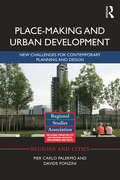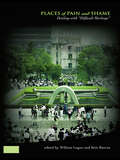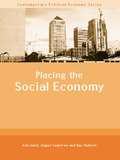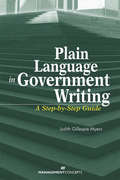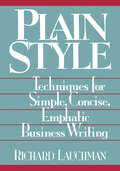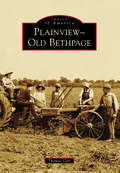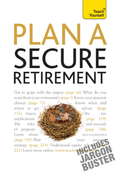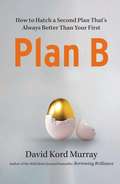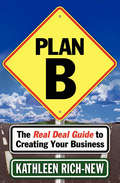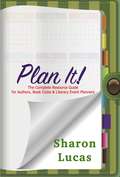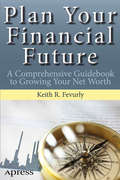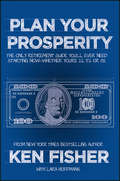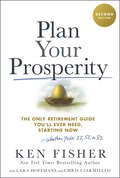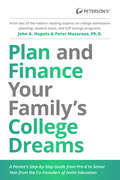- Table View
- List View
Place-making and Urban Development: New challenges for contemporary planning and design (Regions and Cities)
by Pier Carlo Palermo Davide PonziniThe regeneration of critical urban areas through the redesign of public space with the intense involvement of local communities seems to be the central focus of place-making according to some widespread practices in academic and professional circles. Recently, new expertise maintains that place-making could be an innovative and potentially autonomous field, competing with more traditional disciplines like urban planning, urban design, architecture and others. This book affirms that the question of 'making better places for people' should be understood in a broader sense, as a symptom of the non-contingent limitations of the urban and spatial disciplines. It maintains that research should not be oriented only towards new technical or merely formal solutions but rather towards the profound rethinking of disciplinary paradigms. In the fields of urban planning, urban design and policy-making, the challenge of place-making provides scholars and practitioners a great opportunity for a much-needed critical review. Only the substantial reappraisal of long-standing (technical, cultural, institutional and social) premises and perspectives can truly improve place-making practices. The pressing need for place-making implies trespassing undue disciplinary boundaries and experimenting a place-based approach that can innovate and integrate planning regulations, strategic spatial visioning and urban development projects. Moreover, the place-making challenge compels urban experts and policy-makers to critically reflect upon the physical and social contexts of their interventions. In this sense, facing place-making today is a way to renew the civic and social role of urban planning and urban design.
Places
by Simon AnholtPlace branding is happening. A new field of practice and study is in existence and whatever we choose to call it there can no longer be any doubt that it is with us. This collection of intuitive and well-reserached articles examines how places and regions see themselves, and how they reflect this in their branding
Places of Pain and Shame: Dealing with 'Difficult Heritage' (Key Issues in Cultural Heritage)
by William Logan Keir ReevesPlaces of Pain and Shame is a cross-cultural study of sites that represent painful and/or shameful episodes in a national or local community’s history, and the ways that government agencies, heritage professionals and the communities themselves seek to remember, commemorate and conserve these cases – or, conversely, choose to forget them. Such episodes and locations include: massacre and genocide sites, places related to prisoners of war, civil and political prisons, and places of ‘benevolent’ internment such as leper colonies and lunatic asylums. These sites bring shame upon us now for the cruelty and futility of the events that occurred within them and the ideologies they represented. They are however increasingly being regarded as ‘heritage sites’, a far cry from the view of heritage that prevailed a generation ago when we were almost entirely concerned with protecting the great and beautiful creations of the past, reflections of the creative genius of humanity rather than the reverse – the destructive and cruel side of history. Why has this shift occurred, and what implications does it have for professionals practicing in the heritage field? In what ways is this a ‘difficult’ heritage to deal with? This volume brings together academics and practitioners to explore these questions, covering not only some of the practical matters, but also the theoretical and conceptual issues, and uses case studies of historic places, museums and memorials from around the globe, including the United States, Northern Ireland, Poland, South Africa, China, Japan, Taiwan, Cambodia, Indonesia, Timor and Australia.
Places of the Imagination: Media, Tourism, Culture
by Stijn ReijndersRecent years have seen an explosive growth in the phenomenon of people visiting locations from popular novels, films or television series. Places of the Imagination presents a timely and insightful analysis of this form of media tourism, exploring the question of how best to explain the increasing popularity of media tourism within contemporary culture. Drawing on extensive empirical and interview material, this book examines the representation of landscapes in popular narratives that have inspired media tourism, whilst also investigating the effects over time of such tourism on local landscapes, and the processes by which tourists appropriate the landscape, experiencing and accommodating them into their imagination. Oriented around three central case studies of popular television detective shows, famous films and classic literature, Places of the Imagination develops a new theoretical understanding of media tourism. As such, it will appeal to sociologists and cultural geographers, as well as those working in the fields of media and cultural studies, popular and fan culture, tourism and the sociology of leisure.
Placing Strategic Bets: The Portfolio Approach--Measuring and Managing Innovation Risk
by Harvard Business Review PressCompany strategy describes how an enterprise aims to differentiate itself in the marketplace. It's up to company leaders to articulate both a strategy and the areas within which they will support innovative ideas and projects. Like a share of corporate stock, every project has a unique risk-return profile. Decision makers need a method for measuring and managing the risk and return characteristics of innovative initiatives. This chapter discusses portfolio and risk management. This chapter was originally published as chapter 10 of "Harvard Business Essentials: The Innovator's Toolkit."
Placing the Social Economy (Routledge Studies In Contemporary Political Economy Ser.)
by Ash Amin Angus Cameron Ray HudsonIn recent years there has been a great deal of discussion about the social economy and the term 'the third way' has attained a level of household recognition, especially in America and Britain. Academics and commentators have debated the usefulness of the social economy as a restraint on capitalist excesses with some arguing that the 'third way' is
Plagues upon the Earth: Disease and the Course of Human History (The Princeton Economic History of the Western World #106)
by Kyle HarperA sweeping germ’s-eye view of history from human origins to global pandemicsPlagues upon the Earth is a monumental history of humans and their germs. Weaving together a grand narrative of global history with insights from cutting-edge genetics, Kyle Harper explains why humanity’s uniquely dangerous disease pool is rooted deep in our evolutionary past, and why its growth is accelerated by technological progress. He shows that the story of disease is entangled with the history of slavery, colonialism, and capitalism, and reveals the enduring effects of historical plagues in patterns of wealth, health, power, and inequality. He also tells the story of humanity’s escape from infectious disease—a triumph that makes life as we know it possible, yet destabilizes the environment and fosters new diseases.Panoramic in scope, Plagues upon the Earth traces the role of disease in the transition to farming, the spread of cities, the advance of transportation, and the stupendous increase in human population. Harper offers a new interpretation of humanity’s path to control over infectious disease—one where rising evolutionary threats constantly push back against human progress, and where the devastating effects of modernization contribute to the great divergence between societies. The book reminds us that human health is globally interdependent—and inseparable from the well-being of the planet itself.Putting the COVID-19 pandemic in perspective, Plagues upon the Earth tells the story of how we got here as a species, and it may help us decide where we want to go.
Plain Language in Government Writing: A Step-by-Step Guide (Management Concepts)
by Judith Gillespie MyersA Plain-English Guide to Government Writing Whether you're in the public or private sector, good writing skills are critical to your success in the workplace. Plain Language in Government Writing: A Step-by-Step Guide shows you how to apply federal plain-language guidelines to every type of writing — from emails, memos, and letters to agency communications, technical procedures, and budget justification statements. Through numerous exercises as well as examples from a variety of federal and state agencies, this practical guide walks you step-by-step through every phase of the writing process, providing tips for improved clarity, conciseness, and completeness. This valuable reference will help you: Write for diverse audiences in reader-friendly, plain languageOvercome writer's blockGain confidence in your ability to write — and get resultsMake your writing visually appealingPrepare for briefings and presentationsRecognize successful writing and identify what makes it effectiveA Plain-English Guide to Government Writing will enable you to express yourself more clearly and concisely, produce documents more efficiently, and work more effectively with others throughout the writing process.
Plain Style: Techniques for Simple, Concise, Emphatic Business Writing
by Richard LauchmanGood writing is good business. Simple, straightforward writing saves time, creates good relationships, and prevents expensive misunderstandings. But why is it so hard to achieve? This incisive guide suggests ways to think about writing -- what it should look and sound like, as well as what it should accomplish -- that can simplify how writers choose to express their ideas. It examines the reasons why many businesspeople with good skills tend to write strange, needlessly complicated sentences -- and shows them how to break the habit. Plain Style offers 35 practical techniques that foster simplicity, conciseness, and emphasis.
Plainview-Old Bethpage
by Thomas CarrPlainview–Old Bethpage presents an intriguing story of two vibrant Long Island communities that share a colorful 300-year-old history. They were once quaint farming communities that almost overnight found themselves facing seismic cultural changes. In just 10 years, from 1950 to 1960, the combined population of Plainview and Old Bethpage soared from 2,000 to over 33,000. Plainview–Old Bethpage presents a journey back in time to the Native Americans, the settlers who followed, the farmers who worked the land, and the thousands who came to make a better life for their families. Discover why every town surrounding Plainview–Old Bethpage has a railroad station but it does not. Read about the resident who raised a Confederate flag during the Civil War and drew the ire of his neighbors. Ride along with race car drivers as they hurtle along dirt roads at breakneck speed. Learn about the deadly brawl on Election Day in 1890, the infamous Plainview kidnapper who got the electric chair, and a local company’s role in molding a national memorial to Vietnam veterans.
Plan A Secure Retirement: Teach Yourself (TY Business Skills)
by Trevor GoodbunAre you only a few years away from retirement and fearful of how you will manage, particularly in the current financial climate? This book is aimed at those about to retire who want to make the most of their money in retirement but it's about much more than just pensions. All other aspects of managing finances for retirement are covered, from getting the best deal on a current account to leaving an inheritance in the most tax efficient way. And all in just one handy, portable book complete with jargon-buster!Each chapter covers a specific aspect of retirement finances providing the facts in an understandable way, along with advice and tips. Throughout the book, case studies and the author's extensive personal experience of dealing with pension planning are used to clearly illustrate the points being made. No book can replace specific tailored advice from an expert but this book will help you to make more of your money through your own actions and tell you exactly where expert help is needed. Areas covered include:-Understanding pensions-Essential things to do and find out before retiring-Income tax, capital gains tax and National Insurance-Investments, including investing in property and equity release-Passing on wealthand the book finishes with advice on things you can do after retirement to help your financesWritten in a clear and reassuring way it will melt away the mystique of pensions and tackle the all-round financial aspects of planning for a comfortable retirement.NOT GOT MUCH TIME?One, five and ten-minute introductions to key principles to get you started.AUTHOR INSIGHTSLots of instant help with common problems and quick tips for success, based on the authors' many years of experience.TEST YOURSELFTests in the book and online to keep track of your progress.EXTEND YOUR KNOWLEDGEExtra online articles at www.teachyourself.com to give you a richer understanding of NLP.FIVE THINGS TO REMEMBERQuick refreshers to help you remember the key facts.TRY THISInnovative exercises illustrate what you've learnt and how to use it.
Plan A Secure Retirement: Teach Yourself (Teach Yourself Business Skills Ser.)
by Trevor GoodbunAre you only a few years away from retirement and fearful of how you will manage, particularly in the current financial climate? This book is aimed at those about to retire who want to make the most of their money in retirement but it's about much more than just pensions. All other aspects of managing finances for retirement are covered, from getting the best deal on a current account to leaving an inheritance in the most tax efficient way. And all in just one handy, portable book complete with jargon-buster!Each chapter covers a specific aspect of retirement finances providing the facts in an understandable way, along with advice and tips. Throughout the book, case studies and the author's extensive personal experience of dealing with pension planning are used to clearly illustrate the points being made. No book can replace specific tailored advice from an expert but this book will help you to make more of your money through your own actions and tell you exactly where expert help is needed. Areas covered include:-Understanding pensions-Essential things to do and find out before retiring-Income tax, capital gains tax and National Insurance-Investments, including investing in property and equity release-Passing on wealthand the book finishes with advice on things you can do after retirement to help your financesWritten in a clear and reassuring way it will melt away the mystique of pensions and tackle the all-round financial aspects of planning for a comfortable retirement.NOT GOT MUCH TIME?One, five and ten-minute introductions to key principles to get you started.AUTHOR INSIGHTSLots of instant help with common problems and quick tips for success, based on the authors' many years of experience.TEST YOURSELFTests in the book and online to keep track of your progress.EXTEND YOUR KNOWLEDGEExtra online articles at www.teachyourself.com to give you a richer understanding of NLP.FIVE THINGS TO REMEMBERQuick refreshers to help you remember the key facts.TRY THISInnovative exercises illustrate what you've learnt and how to use it.
Plan B
by David K MurrayWhy has Facebook been so limber, evolving so successfully even after a number of stumbles, while Myspace stalled and lost ground? Why was Wal-Mart able to expand so successfully into new offerings, such as groceries, while H&R Block dramatically failed to expand into offering financial services? The answer, David Murray reveals, is that Facebook and Wal-Mart both started with business models that empowered them to effectively adapt their plans as they executed them. The failure of detailed strategic plans that have taken a great deal of time and money to develop is one of the worst problems in business, and it's ever more urgent as the pace of change in business continues to accelerate. Murray, author of the acclaimed Wall Street Journal bestseller Borrowing Brilliance, argues that valiantly sticking to even a well-thought-out Plan A is the road to disaster. The greatest success comes to those who know how to construct and implement an adaptive Plan A that has within it the means of evolving into a superior Plan B by responding to problems confronted, discoveries made, changing market conditions, and the competition. Writing in a lively, engaging voice and using a series of specific examples drawn from companies including IBM, Intel, Facebook, American Express, and Kaiser Permanente, as well as from the art of war, including the Battle of Gettysburg and the D-Day invasion, and even from the space program, Murray presents powerful methods for constructing a plan that has the mechanisms for adaptation built in. Drawing on a wealth of research, he explains why we are fairly good at short-term predictions but why, in our ever more rapidly changing business world, even the best laid plans will eventually go astray. He then introduces the best techniques for creating an optimal original plan that takes into account our limited ability to predict, showing that vital to this process is that it be constructed so that we are alerted in time to make the right changes. In a brilliant discussion of strategy and tactics, he shows that the core of this adaptability is making sure that your strategy and tactics are well aligned with one another and that you have established the right metrics for measuring results. He then details precisely how to adapt throughout the execution process by constantly monitoring and assessing results, developing worst-case scenarios, and recognizing unanticipated opportunities. Plan B is an essential guide to harnessing the forces of change to achieve long-lasting success despite the most vexing challenges.
Plan B: How to Hatch a Second Plan That's Always Better Than Your First
by David Kord MurrayWhy has Facebook been so limber, evolving so successfully even after a number of stumbles, while Myspace stalled and lost ground? Why was Wal-Mart able to expand so successfully into new offerings, such as groceries, while H&R Block dramatically failed to expand into offering financial services? The answer, David Murray reveals, is that Facebook and Wal-Mart both started with business models that empowered them to effectively adapt their plans as they executed them. The failure of detailed strategic plans that have taken a great deal of time and money to develop is one of the worst problems in business, and it's ever more urgent as the pace of change in business continues to accelerate. Murray, author of the acclaimed Wall Street Journal bestseller Borrowing Brilliance, argues that valiantly sticking to even a well-thought-out Plan A is the road to disaster. The greatest success comes to those who know how to construct and implement an adaptive Plan A that has within it the means of evolving into a superior Plan B by responding to problems confronted, discoveries made, changing market conditions, and the competition. Writing in a lively, engaging voice and using a series of specific examples drawn from companies including IBM, Intel, Facebook, American Express, and Kaiser Permanente, as well as from the art of war, including the Battle of Gettysburg and the D-Day invasion, and even from the space program, Murray presents powerful methods for constructing a plan that has the mechanisms for adaptation built in. Drawing on a wealth of research, he explains why we are fairly good at short-term predictions but why, in our ever more rapidly changing business world, even the best laid plans will eventually go astray. He then introduces the best techniques for creating an optimal original plan that takes into account our limited ability to predict, showing that vital to this process is that it be constructed so that we are alerted in time to make the right changes. In a brilliant discussion of strategy and tactics, he shows that the core of this adaptability is making sure that your strategy and tactics are well aligned with one another and that you have established the right metrics for measuring results. He then details precisely how to adapt throughout the execution process by constantly monitoring and assessing results, developing worst-case scenarios, and recognizing unanticipated opportunities. Plan B is an essential guide to harnessing the forces of change to achieve long-lasting success despite the most vexing challenges.
Plan B: The Real Deal Guide to Creating Your Business
by Kathleen Rich-NewA practical, sensible plan for finding the type of self-employment that suits you, and taking charge of your own future. If you dream of getting out of job jail—or if a layoff has left you thinking about finally pursuing your entrepreneurial dreams—this easy-to-read guide shows you how to create a Plan B business that fits your skills, interests, and preferred work lifestyle. You will learn the four ways to create an income when there aren&’t any jobs available—or any jobs that interest you. Filled with stories of successes and failures, this practical book covers the good, the bad, and the ugly about each of the business models, so you can make smart decisions, avoid mistakes and pitfalls, and find a better alternative for a fulfilling life when Plan A just isn&’t working for you anymore.
Plan It!
by Sharon LucasThe Perfect Planning Guide for Book clubs! The African American author is often overworked, overlooked and underrated. That coupled with the closing of many bookstores, which had long been the gathering place for these authors, and the emergence of E-readers, has changed the way in which our writers and readers meet and converse. Though book clubs have long been a cornerstone of the African American community, at no other time in our history has it been more important for readers to support African American authors and to help fill the void left by the closing of our brick and mortar stores. A well organized book club can be invaluable in spreading the news about great books and talented authors and what better way to achieve that than bringing these two groups together in a well-planned and executed literary event. Plan It! The Complete Resource Guide for Authors, Book Clubs, & Literary Event Planners provides anyone who wants to start a book club with an all-in-one guide to planning book club and literary events. This required companion includes forms, checklists, and tips to start and manage book club meetings, author visits, and planning full-scale literary events. Not just for book clubs, though, this handy guide also provides authors and event planners with the information they need to make any event a resounding success.
Plan Operations: Align Process Improvement Programs
by Robert S. Kaplan David P. NortonPerformance that depends on the power of individual leaders has generally proven unsustainable over the long term. Unless an organization links its strategy to its governance and operational processes, it won't be able to sustain its successes. This chapter discusses the linkage of strategy to process improvements.
Plan Operations: Sales Forecasts, Resource Capacity, and Dynamic Budgets
by Robert S. Kaplan David P. NortonThis chapter presents an integrated approach for linking the strategic plan to forecasts for spending on operating and capital resources, which accounts for the vast majority of overall corporate spending. This process ensures that resource capacity, operational plans, and budgets reflect the direction and needs of the strategy.
Plan Your Estate
by Denis CliffordTurn to Plan Your Estate for straightforward, plain-English explanations of each of your estate-planning options, so you can make the best decisions for you and those you love. Attorney Denis Clifford shows you how to: avoid probate leave property through a will or trust use life insurance to provide for your loved ones name a guardian for your minor children leave property to a young person plan for incapacity implement strategies specific to business owners reduce estate taxes, and make final arrangements. Applies in all U.S. states except Louisiana.
Plan Your Estate
by Denis CliffordProtect your family with solid estate planning Estate planning sounds difficult—but most people just need a few basic documents. Let Plan Your Estate show you how to protect your loved ones from legal hassles and financial uncertainty after your death. Learn about: wills and living trusts avoiding probate bypass (AB) trusts naming guardians for children leaving property to children estate, gift, and inheritance taxes strategies for business owners leaving property to charity health care directives, and financial powers of attorney. The 15th edition of Plan Your Estate is completely updated to reflect the latest state and federal laws. Applies in all U.S. states except Louisiana. (Note: This book contains no estate planning forms, but it does tell you how to get the forms you need.)
Plan Your Financial Future
by Keith R. FevurlyImplementing a financial plan to manage the future is very important. If you have not assembled such a plan, or even if you have not thought about how best to manage your financial future, the time to do so is now, and the resource you need to walk you through every step of the personal financial planning process is Plan Your Financial Future. Regardless of whether you are a recent college graduate or have spent the past several decades in the working world, Plan Your Financial Future will give you the smart, commonsense advice you need to get your financial life in order. Written by an expert and long-standing educator in the field of personal financial planning, Plan Your Financial Future is a comprehensive, objective, and pertinent guidebook for readers of all income levels who want to grow their net worth on a steady and increasing basis. Covering all the financial bases you can reasonably expect to confront in your lifetime, like insurance, investing, income tax planning, Social Security, Medicare, and more, this vital resource begins with techniques to protect a consumer''s personal and business assets. It then transitions into the wealth accumulation process and outlines tax management measures, as well as the distribution of wealth for higher education, retirement, and estate planning purposes. Filled with in-depth insight and invaluable financial planning advice, this unique guide explains how to: Insure yourself, your family, and your property against the possibility of significant loss; Invest in financial or real assets--or both; Practice effective tax planning and management techniques; Distribute your estate at death to your intended beneficiaries in a tax-efficient manner; And much more. With its no-nonsense, straightforward style and holistic view of the financial planning process, Plan Your Financial Future is the one resource you need to become a more knowledgeable saver and translate those savings into the accumulation of future wealth. What you''ll learn Readers of Plan Your Financial Future will learn: How to take advantage of benefits that are offered to them by their employer The importance of minimizing the effects of inflation on their portfolios as much as possible Financial strategies for preparing for their children''s higher education Rock-solid advice for planning for the financial aspects of their retirement years Whether or not they would benefit from the hiring of a professional financial planner How to create and maintain a personal financial plan that protects them and their families into the future Who this book is for Plan Your Financial Future is designed for readers of all income levels who would like grow their net worth on a steady and increasing basis by implementing and sticking to a personal financial plan. Everyone from recent college graduates to those who have been in the working world for many years will benefit from the insightful, actionable advice offered up in Plan Your Financial Future. Table of Contents Understanding the Challenge/The Need to Begin Do You Need a Financial Planner? Elements of Personal Financial Planning and the Wealth Management Process Insuring Yourself and Your Family Insuring Your Health and Long Term Care Insuring Your Earning Power Insuring Your Property Optimizing Your Employment Benefits Investing in Financial Assets Investing in Real Assets Employing Assets Profitably Income Tax Planning and Management Transfer Tax Planning and Management Life Events that Endanger Wealth Planning for Your Child''s Higher Education Planning for the Financial Aspects of Retirement Planning for the Lifestyle Needs of Retirement Planning for Other Lifetime Goals Estate Planning Philanthropy Reaping the Rewards Sample Data Gathering Form Sample Budget Durable General and Financial Power of Attorney (POA) Declaration as to Medical or Surgical Treatment and Medical Durable POA Sample Personal Letter of Instructions Glossary
Plan Your Financial Future: A Comprehensive Guidebook to Growing Your Net Worth
by Keith R. FevurlyGet your financial life in order. This comprehensive and objective guidebook will help you grow your net worth on a steady and increasing basis, regardless of your income level.This new and expanded edition covers changes and strategies to maximize financial benefits and planning resulting from the recent tax legislation, beginning January 2018, and changes to the Affordable Care and Protection Act of 2010. Covering all the financial bases you can reasonably expect to confront in your lifetime, such as insurance, investing, income tax planning, Social Security, Medicare, and more, this vital resource begins with techniques to protect a consumer's personal and business assets. It then transitions into the wealth accumulation process and outlines tax management measures, as well as the distribution of wealth for higher education, retirement, and estate planning purposes. Written by an expert and long-standing educator in the field of personal financial planning, Plan Your Financial Future is a no-nonsense, straightforward, and holistic view of the financial planning process. It is the one resource you need to become a more knowledgeable saver and translate those savings into the accumulation of future wealth. What You'll Learn Insure yourself, your family, and your property against the possibility of significant loss Invest in financial or real assets—or both Implement effective tax planning and management techniques Distribute your estate at death to your intended beneficiaries in a tax-efficient mannerDiscover strategies to maximize financial health taking into consideration the new tax legislation, effective January 1, 2018 Who This Book Is ForRegardless of whether you are a recent college graduate or have spent the past several decades in the working world, this book will give you the smart, commonsense advice you need to get your financial life in order.
Plan Your Prosperity: The Only Retirement Guide You'll Ever Need, Starting Now--Whether You're 22, 52 or 82
by Kenneth L. FisherWhether you're in retirement, just getting ready to retire, or 5, 10, or 40 years out, this book can help you invest smarter your whole life and yes, plan better for retirement. Harmful mythology abounds about retirement investing.<P><P> Many retirees or soon-to-be retirees have heard a plethora of advice. Take 100 (or 120) and subtract your age to get your equity allocation, put the rest in bonds or cash. Buy only bonds. Buy only high dividend stocks. Or some combination! Buy equity-indexed annuities or some "guaranteed" income product. All examples of a potentially harmful myth many folks believe to be smart, strategic moves. Investors believe preparing for retirement requires a radically different set of tools or a dizzying array of products. Navigating the world of retirement products and services can be a full-time job. But investing for retirement is, in practice, not much (if at all) different from investing. In Your Retirement Plan, Ken Fisher will give readers a workable strategy to either develop their own retirement investing plan or work more successfully with a professional to increase the likelihood of achieving long-term goals while avoiding common pitfalls. The book will include easy-to-follow steps like How to think, correctly, about investing time horizon. How to better figure how much income you need How to determine if a portfolio can provide that income How to figure how much to save each year to achieve retirement goals What pitfalls to avoid And more. . . . In this retirement planning book that's not just for retirees, Fisher will hand readers the tools and confidence they need to better plan for the future.
Plan Your Prosperity: The Only Retirement Guide You'll Ever Need, Starting Now-Whether You're 22, 52 or 82
by Kenneth L. FisherAn essential roadmap to financial security and independence in retirement In the newly revised second edition of Plan Your Prosperity: The Only Retirement Guide You’ll Ever Need, Starting Now—Whether You’re 22, 52 or 82, renowned investment adviser Ken Fisher delivers a practical and insightful new discussion of why all your investing should be done with an eye toward retirement. You’ll learn how to think about investing for retirement and learn to understand key concepts like time horizons, return expectations, and cash flow needs. You’ll discover how to select an appropriate retirement benchmark and how to determine how much you need to save each year to achieve your retirement goal. The book also includes: A comprehensive, workable strategy to develop your own retirement investing plan or work with a professional to do that while avoiding common pitfalls Techniques for avoiding harmful myths about retirement saving and investing, like complex and expensive annuities and other products Hands-on strategies for figuring out how much income you need to ensure the maintenance of your lifestyle in retirement Perfect for working people at any stage of their career who are interested in working toward financial security and independence, Plan Your Prosperity is a must-read roadmap to successful investing and saving.
Plan and Finance Your Family's College Dreams: A Parent's Step-By-Step Guide from Pre-K to Senior Year
by Peter Mazareas John HupaloPlanning and paying for a college education is a daunting task for most parents. It is a stressful and costly process that needs a well-thought-out academic and financial strategy. This guide offers just that! Two of the nation's leading college planning and financing experts provide clear step-by-step guidance on how to successfully save, plan for, apply to, and finance a college education. Age- and grade-appropriate guidance empowers families with children of all ages, with detailed information on preparing, financing, and successfully applying to college. Financing a college education requires a good look at all available options: savings, free money, financial aid, and loans. Finding the right savings vehicle and investments is important. Learn the pros and cons of various savings and investment options, including Bank accounts, 529 Plans, Coverdell Education Savings Accounts, and more-so you can begin to develop your plan. Easy-to-understand explanations help parents better understand college loans, including details about federal and private loans, consolidation and refinancing of loans, as well as a discussion on what it means to co-sign a loan. Based on the expert advice presented in this book, parents will be able to create a personalized college admission and financing plan that is unique to their family.
